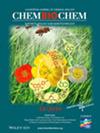Front Cover: Development of a Highly Selective NanoBRET Probe to Assess MAGL Inhibition in Live Cells (ChemBioChem 6/2025)
IF 2.6
4区 生物学
Q3 BIOCHEMISTRY & MOLECULAR BIOLOGY
引用次数: 0
Abstract
The histamine subtype 3 receptor (H3R) is mainly expressed in the brain, where it plays a key role in various neurological functions. This brain imaging, featuring glowing neural connections, highlights the high expression of H3R. The molecular structure approaching the brain represents new Positron Emission Tomography (PET) probes for precise brain imaging. The light trail indicates the potential of this PET probe to visualize H3R, providing insights into brain function and pathology. More details can be found in Research Article 10.1002/cbic.202400704 by Magnus Schou, Steven H Liang, and co-workers.

求助全文
约1分钟内获得全文
求助全文
来源期刊

ChemBioChem
生物-生化与分子生物学
CiteScore
6.10
自引率
3.10%
发文量
407
审稿时长
1 months
期刊介绍:
ChemBioChem (Impact Factor 2018: 2.641) publishes important breakthroughs across all areas at the interface of chemistry and biology, including the fields of chemical biology, bioorganic chemistry, bioinorganic chemistry, synthetic biology, biocatalysis, bionanotechnology, and biomaterials. It is published on behalf of Chemistry Europe, an association of 16 European chemical societies, and supported by the Asian Chemical Editorial Society (ACES).
 求助内容:
求助内容: 应助结果提醒方式:
应助结果提醒方式:


